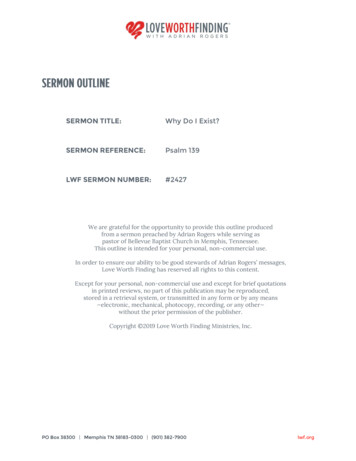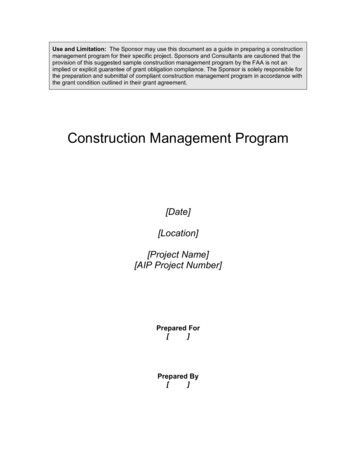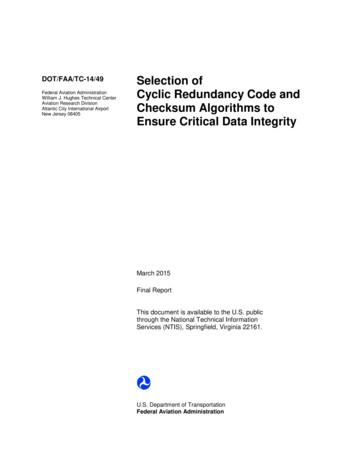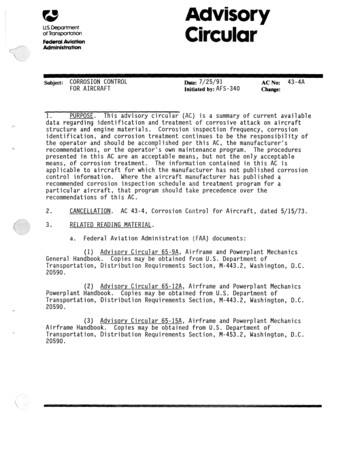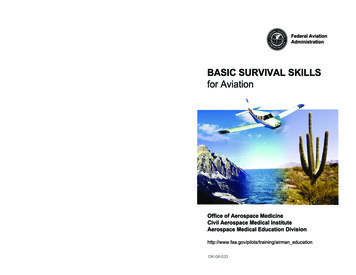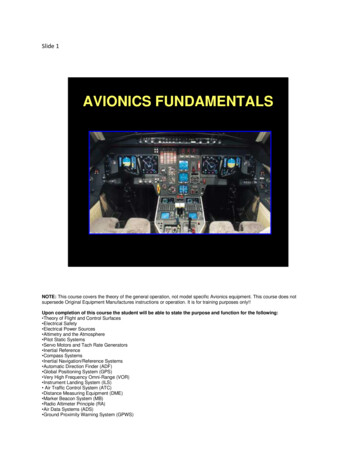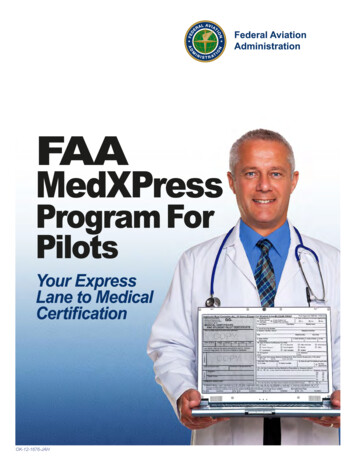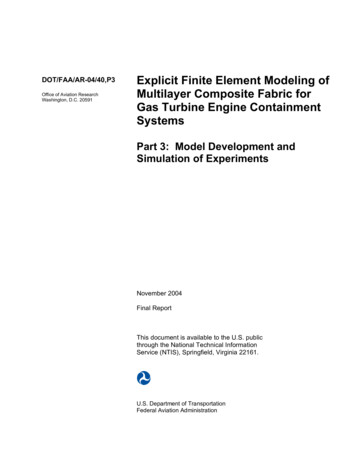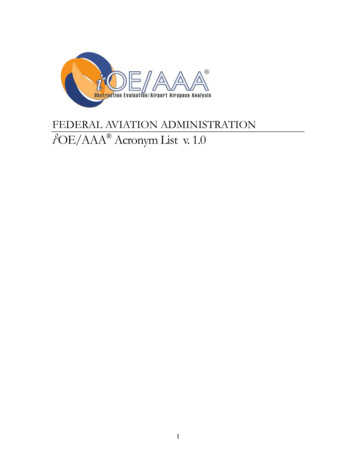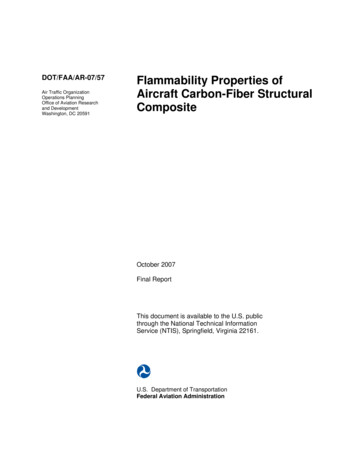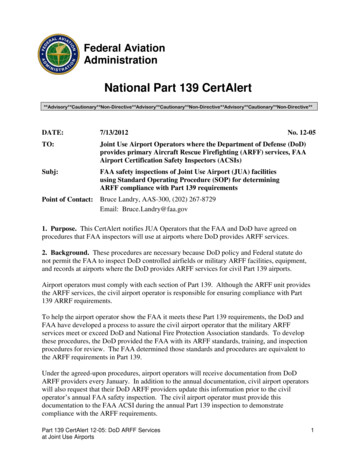
Transcription
Federal AviationAdministrationNational Part 139 onary**Non-Directive**DATE:7/13/2012No. 12-05TO:Joint Use Airport Operators where the Department of Defense (DoD)provides primary Aircraft Rescue Firefighting (ARFF) services, FAAAirport Certification Safety Inspectors (ACSIs)Subj:FAA safety inspections of Joint Use Airport (JUA) facilitiesusing Standard Operating Procedure (SOP) for determiningARFF compliance with Part 139 requirementsPoint of Contact: Bruce Landry, AAS-300, (202) 267-8729Email: Bruce.Landry@faa.gov1. Purpose. This CertAlert notifies JUA Operators that the FAA and DoD have agreed onprocedures that FAA inspectors will use at airports where DoD provides ARFF services.2. Background. These procedures are necessary because DoD policy and Federal statute donot permit the FAA to inspect DoD controlled airfields or military ARFF facilities, equipment,and records at airports where the DoD provides ARFF services for civil Part 139 airports.Airport operators must comply with each section of Part 139. Although the ARFF unit providesthe ARFF services, the civil airport operator is responsible for ensuring compliance with Part139 ARRF requirements.To help the airport operator show the FAA it meets these Part 139 requirements, the DoD andFAA have developed a process to assure the civil airport operator that the military ARFFservices meet or exceed DoD and National Fire Protection Association standards. To developthese procedures, the DoD provided the FAA with its ARFF standards, training, and inspectionprocedures for review. The FAA determined those standards and procedures are equivalent tothe ARFF requirements in Part 139.Under the agreed-upon procedures, airport operators will receive documentation from DoDARFF providers every January. In addition to the annual documentation, civil airport operatorswill also request that their DoD ARFF providers update this information prior to the civiloperator’s annual FAA safety inspection. The civil airport operator must provide thisdocumentation to the FAA ACSI during the annual Part 139 inspection to demonstratecompliance with the ARFF requirements.Part 139 CertAlert 12-05: DoD ARFF Servicesat Joint Use Airports1
The data provided will include: A summary of the last annual self-inspection. This will focus on the ARFFrequirements under Part 139.The date and result of the last major outside inspection (i.e., Major command, staff,Inspector General, or Center for Public Safety Excellence).An ARFF vehicle report that lists at least the type and status of all ARFF vehiclesneeded to satisfy the Part 139 requirements, but may list all ARFF vehicles.A summary of training dates for specific items required under Part 139. Thissummary may be produced electronically from automated systems or preparedmanually using a spreadsheet.Additional information in accordance with the attached SOP.The FAA inspectors will review the documents provided for completeness and work with thecivil airport operator to resolve any issue or concerns.FAA inspectors will coordinate with the civil airport operator and not the DoD provider. Allcommunication about ARFF services are between the DoD provider and the civil airportoperator.The FAA inspectors will not inspect DoD vehicles, equipment, or facilities, nor will theyconduct timed drills.3. Effective Date: These procedures are effective on July 10, 2012.4. Enclosure: DoD Memorandum dated April 3, 2012 and ARFF Inspection SOP7/13/2012Michael J. O'Donnell, DirectorAirport Safety and Standards, AAS-1DatePart 139 CertAlert 12-05: DoD ARFF Servicesat Joint Use Airports2
Part 139 CertAlert 12-05: DoD ARFF Servicesat Joint Use Airports3
Part 139 CertAlert 12-05: DoD ARFF Servicesat Joint Use Airports4
Part 139 CertAlert 12-05: DoD ARFF Servicesat Joint Use Airports5
Airport Rescue and Fire Fighting (ARFF) Services Supplied by theDepartment of Defense (DoD) and Civil Airport Operators1. Introduction: Certificated airport operators must comply with all aspects of 14 CFR, Part139. This document provides the procedures for Federal Aviation Administration (FAA)inspectors to determine whether a Part 139 civil airport operator is meeting Part 139 ARFFrequirements at an airport where ARFF services are provided by the DoD.2. DoD/FAA Agreement: The FAA determined that DoD ARFF standards are equivalent to orexceed Part 139 requirements. The DoD will provide the civil airport operator (certificateholder) a package of standard documents that validate the DoD meets its ARFF requirements.3. FAA Inspections: The civil airport operator will give FAA inspectors the completeddocumentation provided by the DoD. This documentation will include the items required tosatisfy the ARFF portion of Part 139. Inspectors will review the standard package forcompleteness and work with the civil airport operator to resolve any issues or questions.3.1. FAA inspectors will coordinate with the civil airport operator, not the DoD. The civilairport operator will interface with their ARFF provider. All communications regarding DoDARFF services are between the DoD provider and the civil airport operator.3.1.2. No direct communication occurs between the DoD provider and FAA inspectors. FAAinspectors will not inspect DoD vehicles, equipment, or facilities and will not conduct timedresponse drills.4. Due Diligence: The civil airport operator must provide evidence that they meet Part 139regulatory standards. In order for the civil airport operator to demonstrate that the airport meetsPart 139 ARFF requirements, the DoD Fire Chief will send a memorandum (Appendix A) to thecivil airport operator showing that the DoD fire department meets DoD standards that affect theARFF services provided to the civil airport. The local DoD Fire Chief will provide thismemorandum to the civil airport operator in January of each calendar year and as requested bythe civil airport operator prior to their annual FAA Part 139 inspection. The memo will includethe following elements:4.1. Introductory Paragraph: An introductory paragraph stating that the local fire departmentmeets DoD ARFF requirements.4.2. Include the following documentation as attachments to the memorandum:4.2.1. Civil Airport ARFF Operations Checklist. An example is provided at Appendix A,Attachment 1.4.2.2. External Inspection. The date of the last major external inspection (Major Command(MAJCOM) staff, Inspector General or Center for Public Safety Excellence). The frequency ofexternal inspections may vary but is normally conducted at three to five year intervals.Part 139 CertAlert 12-05: DoD ARFF Servicesat Joint Use Airports6
EXPLANATION: Each DoD ARFF facility is inspected by external organizations to validatecompliance with standards. Inspection can be by a MAJCOM staff, the Inspector General oranother official external source. Accreditation by the Center for Public Safety Excellence alsoserves as proof of compliance with standards.The memo will identify the external organization conducting the inspection and the date. If theexternal inspection results in ARFF related discrepancies, the DoD Fire Chief will inform thecivil airport operator and explain how the discrepancies were resolved. DoD will not provide theactual inspection documents since they are for Official Use Only.4.2.3. ARFF Vehicle Report. Provide ARFF vehicle information using the format at AppendixA, Attachment 2.EXPLANATION: This report is provided by the DoD Fire Chief to the civil airport operator inJanuary of each year. The report may list all assigned ARFF vehicles or only those required tosatisfy Part 139 requirements. The civil airport operator determines the appropriate actionnecessary when a vehicle’s status changes. The DoD Fire Chief and the airport operator developprocedures for the DoD Fire Chief to inform the civil airport operator when an ARFF vehicle isnot available.DoD ARFF vehicles may incorporate ultra high pressure (UHP) fire fighting technology. UHPincreases the effectiveness of AFFF agent by a factor of 3.5. For vehicles less than 1500 gallonscapacity, FAA inspectors will use the equivalent capacity determined by multiplying the actualgallons times 3.5. The equivalent capacity of turrets is also determined by multiplying the actualdischarge capacity times 3.5. These vehicles meet DoD standards.EXAMPLE: A 500 gallon UHP ARFF vehicle with a 60 GPM turret has an effective capacityof a 1750 ARFF vehicle and a 227 GPM turret using conventional pressures.4.2.4. DoD ARFF Training Summary. Provide a summary of training dates for the subjectslisted at Appendix A, Attachment 3. The report may be electronically produced from automatedsystems or manually prepared using the spreadsheet similar to what is shown in Appendix A,Attachment 3.EXPLANATION: The DoD Fire Chief will provide summary of training dates for firefighters.The number of firefighters in the report will be limited to the number required for the airportindex regardless of the actual number of firefighters that routinely respond to civil aircraftemergencies. DoD firefighters are transitory due to frequent rotation and deployments;therefore, inspectors should expect to see different firefighter names and information from yearto year.FAA Inspectors will accept the DoD ARFF Training Summary provided to the civil airportoperator to document that DoD firefighters satisfied DoD training standards. This attachmentshows the full name of the firefighter, the areas of required training related to ARFF and the lastdate the training was completed. FAA inspectors will ensure the dates for the listed training arewithin the last 12 calendar months (training due in a month can be conducted anytime during thePart 139 CertAlert 12-05: DoD ARFF Servicesat Joint Use Airports7
month). Due to the transient nature of DoD firefighters, FAA inspectors will not request 24months of training data.In the last column of Training Summary, indicate whether the listed firefighters are required tomeet the civil airport’s Index. To determine the Index requirement, multiply the number ofvehicles in the ARFF Vehicle report times 2.65 (round up). When an individual has notcompleted all the required training within 12 consecutive months, list another individual that hascompleted the training and select “no” for this column. The goal is to always provide enoughtrained personnel on the list to satisfy the Part 139 requirements.5. Resolving Deficiencies: If training discrepancies exist, the FAA inspector will ask the civilairport operator for a detailed training report on the subject and/or individual, when adiscrepancy is identified. All requests for additional information will be made through the civilairport operator. The DoD will respond to the request by the civil airport operator in a timelymanner not to exceed 8 normal business hours.6. Unresolved Deficiencies: If discrepancies result in non-compliance with Part 139, the FAAinspector will take appropriate action against the civil airport operator to address the noncompliance in accordance with the FAA Compliance and Enforcement Order and the AirportCertification Handbook.Part 139 CertAlert 12-05: DoD ARFF Servicesat Joint Use Airports8
APPENDIX AOfficial Memorandum with:Attachment 1 - Civil Airport ARFF Operations ChecklistAttachment 2 - Example ARFF Vehicle ReportAttachment 3 - DoD ARFF Training SummaryPart 139 CertAlert 12-05: DoD ARFF Servicesat Joint Use Airports9
Official Letterhead(INSERT DATE)MEMORANDUM FOR (INSERT NAME OF CIVIL AIRPORT MANAGER)FROM: (INSERT OFFICE SYMBOL OF NEXT LEVEL ABOVE FIRE CHIEF)SUBJECT: Certification of Department of Defense (DoD) Aircraft Rescue and Fire Fighting (ARFF) Capability1. This memorandum is provided to document that the (INSERT NAME OF AFB FIRE DEPARTMENT) meetsrequirements for all ARFF in accordance with DoDI 6055.06, Fire & Emergency Services Program.2. The following documentation is provided to substantiate ARFF training and vehicle response capability:a. Completed Civil Airport ARFF Operations Checklist (Attachment 1):DATE:b. Date and overall rating of last external inspection:DATE:INSPECTING AGENCY:EXPLAIN THE CORRECTIVE ACTIONS TAKEN FOR ANY IDENTIFIED DEFICIENCIES THATAFFECT ARFF CAPABILITY AVAILABLE TO RESPOND TO CIVIL AIRCRAFTEMERGENCIES:Note: Inspection reports are for official use only; a copy or the report cannot be provided.c. ARFF Vehicle Report (Attachment 2).d. DoD ARFF Training Summary for DoD firefighters assigned to Civil ARFF duties (Attachment 3).e. Average response time to aircraft emergencies for the previous 90 days.For the period to the average response time to ARFF emergencies was andcompliant with DoD requirements.3. I certify the (INSERT NAME OF DoD FIRE DEPARTMENT) meets all DoD ARFF requirements. If you haveany questions, please contact Chief (FIRE CHIEF’S NAME) at (INSERT COMMERCIAL TELEPHONENUMBER).Fire Chief’s Supervisor Signature BlockAttachments:1. Civil Airport ARFF Operations Checklist2. ARFF Vehicle Report3. DoD ARFF Training SummaryPart 139 CertAlert 12-05: DoD ARFF Servicesat Joint Use Airports10
ATTACHMENT 1 – CIVIL AIRPORT ARFF OPERATIONS CHECKLISTFAA Checklist.xlsxDepartment of Defense Fire and Emergency ServicesCivil Airport ARFF Operations Checklist§ 139Inspection RequirementsReference319(a)ARFF CAPABILITY MEETING INDEX PROVIDED DURING ACR OPNSThe DoD F&ES organizations provides the ARFF Vehicle Report which identifies the DoD vehicles assigned abovethe normal Airport Index requirement. The certificate holder uses this information to determine the Index theF&ES organization can meet.319(b)ARFF REQUIREMENTS MET FOR INCREASE IN INDEXThe DoD F&ES fire chief provides the ARFF Vehicle Report which identifies the DoD vehicles that will respond tocivil aircraft emergencies and their capability. The certificate holder uses this information to determine the Indexthe DoD F&ES organization can support.319(c) & (d) REDUCTION IN ARFF INDEX MEETS CONDITIONSThe DoD F&ES fire chief notifies the certificate holder when any changes occur to the vehicles in the ARFF VehicleReport. The certificate holder takes any action required when ARFF capability drop below the requirementsrequired to meet the Airport Index.319(e)VEHICLE COMMUNICATION IN REQUIRED VEHICLESThe DoD F&ES organizations provides all emergency communication and equipment to comply with NFPA 1221,Standard for the Installation, Maintenance, and Use of Emergency Services Communications Systems, to include theuse of two-way communication between ARFF vehicles and other required Airfield Operations.319(f)VEHICHLE MARKING AND LIGHTINGNON APPLICABLE. DOD VEHICLES ARE NOT PURCHASED WITH AIP FUNDS319(g)VEHICHLE READINESSEach vehicle required under Airport Index must be maintained and be operational during all air carrieroperations. The vehicle status' are provided in the ARFF Vehicle Report (Attachment 2)319(h)RESPONSE DRILLNO RESPONSE EXERCISE WILL BE CONDUCTED. The FAA has accepted the Response Time criteria in DODI 6055.06as being equivalent to Part 139 requirements. DoD F&ES will demonstrate compliance with DoD response timestandards by providing a response time report annually (Jan) and prior to each FAA inspection, containing theARFF response time for the previous 90-days. An example of this report is at Attachment 4).319(i)1PERSONNEL PROPERLY EQUIPPEDDoD requires that all rescue and firefighting personnel are equipped in a manner authorized by the DoD withprotective clothing and equipment needed to perform their duties. These requirements are based on NationalFire Protection Association standards.319(i)2PERSONNEL PROPERLY TRAINEDAll rescue and firefighting personnel required by Aiport Index are properly trained to perform their duties. DoDF&ES will provide a DOD ARFF Training Summary (example at Attachment 3) with the last date of training for eachsubject. This report is limited to only those personnel required for the Index, which is usually significantly fewerthan the total DoD firefighters assigned.319(i)3LIVE-FIRE DRILL EVERY 12 CONSECUTIVE CALENDAR MONTHS (CCM) FOR ALL PERSONNELVerified by ensuring the training in the DOD ARFF Training Summary (Attachment 3) for firefighters was providedwithin the previous 12 CCM. FAA inspections will not ask for additional training data when the training dates onthe DoD ARFF Training Summary are within 12 CCM.319(i)4PERSONNEL TRAINED AND CURRENT IN BASIC EMERGENCY MEDICAL CARE PROVIDED FOR ACR OPNSVerified by information in the DOD ARFF Training Summary (Attachment 3) for firefighters required by AirportIndex.319(i)5RECORD OF TRAINING FOR 24 CCMVerified by ensuring the training in the DOD ARFF Training Summary (Attachment 3) for firefighters was providedwithin the previous 12 CCM. If descrepancies exist, the FAA inspector may request additional information.319(i)6SUFFICIENT PERSONNEL TO MEET REQUIREMENTSSufficient rescue and firefighting personnel are available during all air carrier operations to operate the vehicles,meet the response times, and meet the minimum agent discharge rates required by § 139.317 (Airport Index).These requirements are normally satisfied when one trained firefighter for each required ARFF vehicle is319(i)7available.ALERTING PROCEDURES/EQUIPMENT REQUIREMENTSProcedures and equipment are established and maintained for alerting rescue and firefighting personnel by siren,alarm, or other means authorized by the DoD to any existing or impending emergency requiring their assistance.HAZARDOUS MATERIALS GUIDANCE AVAILABLEEach aircraft rescue and firefighting vehicle responding to an emergency on the airport must be equipped with, orhave available through a direct communications link, the "North American Emergency Response Guidebook"published by the U.S. Department of Transportation.319(k)EMERGENCY ACCESS ROADS ESYES319(j)NON APPLICABLE IF PAVEMENT IS OWNED BY DOD. TO BE ADDRESSED IN FUTURE DOD/FAA AGREEMENTS.Part 139 CertAlert 12-05: DoD ARFF Servicesat Joint Use AirportsYESN/A11
ATTACHMENT 2 – EXAMPLE ARFF VEHICLE REPORTARFF VehicleReport.xlsxDOD ARFF Vehicle InformationCallSignCrash 5Crash 6Crash 7ModelModelManufacturerYear(Type)2006 OshKosh1985 OshKosh2010 OshKoshP-23P-19P-19VehicleStatusIn ServiceIn ServiceIn ServiceSummary:Part 139 CertAlert 12-05: DoD ARFF Servicesat Joint Use AirportsAirport:WaterAFFFCapacity Capacity30001000150050013055AFFFDry um-Based3Sodium-BasedNumber of Vehicles:Total Water Capacity:Total AFFF Capacity:Total Dry Chemical Capacity:MaximumPrimary TurretDischarge Rate5001200 gpm5001000 gpm250500 gpmDry nsPounds12
ATTACHMENT 3 – DoD ARFF TRAINING SUMMARYName:Dates1-Jan-112-Feb-11Airpot Index required?13. Basic Emergency Medical12. Live Fire Training11. Firefighting Operations10. Adapting Structural for ARFF9. Pedestrians and ground vehiclesoperations8. Emergency Aircraft Evacuation7. Airport Emergency Plan DutiesAircraft Cargo Hazards6.5. ARFF Equipment, Hoses, Nozzles, Turretsand Agents4. Personnel Safety3. Emergency Communications(Civil Aircraft)2. Aircraft Familiarization1. Airport Familiarization, includingmarking, lighting, and signsAirport FirefighterCertifcation NumberARFF PersonnelTraining SummaryInitial Live Fire Training (prior to assignment toARFF duties)DOD ARFF TrainingSummary.xlsxY/NSmith -1124-Jun-111-Jan-117-Jun-116-Apr-113-Mar-11 12-Dec-10 YesSeaman, Thomas13298423-Jun-87 15-Feb-11 13-Mar-11 15-Feb-1114-Mar-1131-May-115-Jun-1124-Jun-11 13-Mar-11 15-Feb-112-Feb-119-Jun-118-Apr-113-Sep-10 12-Dec-10 Yes7-Jun-11Ogletree, John9962323-Nov-07 15-Mar-113-Apr-11 11 15-Mar-11Rivera, Joseph8744514-Nov-95 16-Dec-107-May-11 16-Dec-1014-Mar-1129-May-119-Jun-1124
Part 139 ARFF requirements, the DoD Fire Chief will send a memorandum (Appendix A) to the civil airport operator showing that the DoD fire department meets DoD standards that affect the ARFF services provided to the civil airport. Th
